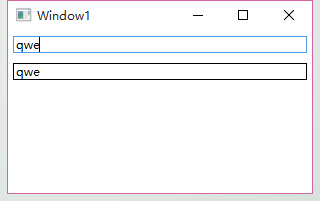依赖属性:一种可以自己没值,并能通过使用Binding从数据源获得值(依赖在别人身上)的属性。
我们做个小例子:将第二个文本框的值依赖到第一个文本框上,即第一个输什么,第二个就显示什么。
先写个简单的XAML页面:
<Window x:Class="MyDependencyProperty.Window1" xmlns="http://schemas.microsoft.com/winfx/2006/xaml/presentation" xmlns:x="http://schemas.microsoft.com/winfx/2006/xaml" Title="Window1" Height="150" Width="200"> <StackPanel> <TextBox x:Name="textBox1" BorderBrush="Black" Margin="5"/> <TextBox x:Name="textBox2" BorderBrush="Black" Margin="5"/> </StackPanel> </Window>
- 然后我们需要写依赖属性,依赖属性永远是用这三个修饰词:public static readonly。
- 它的声明和实例化,使用DependencyProperty.Register方法产生。
- 为了使用方便,我们会对依赖属性进行CLR包装。这样,在使用依赖属性的时候,就跟使用一般的CLR属性一样了。
- SetBinding包装是为了让Person类能够使用绑定方法绑定界面的textBox1的值。
实现一个有依赖属性的类:
public class Person : DependencyObject { /// <summary> /// CLR属性包装器 /// </summary> public string Name { get { return (string)GetValue(NameProperty); } set { SetValue(NameProperty, value); } } /// <summary> /// 依赖属性 /// </summary> public static readonly DependencyProperty NameProperty = DependencyProperty.Register("Name", typeof(string), typeof(Person)); /// <summary> /// SetBinding包装 /// </summary> /// <param name="dp"></param> /// <param name="binding"></param> /// <returns></returns> public BindingExpressionBase SetBinding(DependencyProperty dp, Binding binding) { return BindingOperations.SetBinding(this, dp, binding); } }
然后我们使用Binding把Person的对象per关联到textBox1上,在把textBox2关联到Person对象per上,形成Binding链。
依赖属性使用代码如下:
public Window1() { InitializeComponent(); Person per = new Person(); per.SetBinding(Person.NameProperty, new Binding("Text") { Source = textBox1 }); textBox2.SetBinding(TextBox.TextProperty, new Binding("Name") { Source = per }); }
运行效果:
附加属性:是指一个属性,本来不属于某个对象,但由于某种需求而被后来附加上,也就是放到特定环境里才具有的属性。
比如,人有很多属性,当人在学校里时,会有年级这个属性,这属性不必要一直有,是在学校里而给附加上的
Human类:
class Human : DependencyObject { }
再来个School类:
class School : DependencyObject { public static int GetGrade(DependencyObject obj) { return (int)obj.GetValue(GradeProperty); } public static void SetGrade(DependencyObject obj, int value) { obj.SetValue(GradeProperty, value); } // Using a DependencyProperty as the backing store for Grade. This enables animation, styling, binding, etc... public static readonly DependencyProperty GradeProperty = DependencyProperty.RegisterAttached("Grade", typeof(int), typeof(School), new UIPropertyMetadata(0)); }
我们可以看出来:
- GradeProperty就是DependencyProperty类型成员变量。
- 声明时同样使用public static readonly这三个修饰词。
- 不同的是注册附加属性使用的方法是:RegisterAttached(),但参数却与Register无异。
- 还有不同,包装器不同:依赖属性使用CLR属性对GetValue和SetValue两个方法进行包装;附加属性则使用public static void修饰的两个自命名方法包装。
使用附加属性,如在界面点击Grade的按钮是触发:
private void btn_Grade_Click(object sender, RoutedEventArgs e) { Human human = new Human(); School.SetGrade(human, 6); int grade = School.GetGrade(human); MessageBox.Show(grade.ToString()); }
它的前台界面:
<Grid> <Button Content="Grade" Width="120" Height="25" x:Name="btn_Grade" Click="btn_Grade_Click" /> </Grid>
运行为: